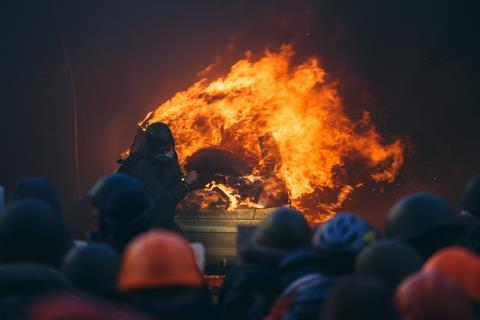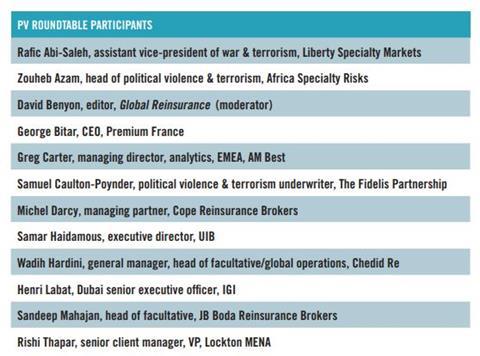Demand for political violence (PV) protection has risen across MENA markets, driven by geopolitical volatility, as well as growing client awareness about this nascent product. A roundtable on day two took a deep dive into an evolving market.
There has been a global rise in insurance claims from strikes, riots, civil commotion (SRCC). Primary market SRCC exclusions in local markets have fed standalone PV, creating fresh demand and higher rates, and an increasing number of insurers are underwriting PV from the DIFC. These were the issues discussed in day two’s PV roundtable, hosted by GR editor David Benyon.

“PV has transformed in recent years, with a tremendous increase in demand,” said one participant. “Some multinationals and firms active in volatile regions have always bought PV, but there is now more interest and product awareness among brokers and clients.”
Reinsurers’ response to Russia’s invasion of Ukraine, further changed PV’s supply and demand dynamics, with a hardened reinsurance market. PV is typically bought by local insurers on a facultative basis – along with war risk markets, and tightened capacity availability.
Another participant said: “We see demand where territories are experiencing unrest and from the regions surrounding these territories.
Suddenly, interest goes up for buying PV, or existing buyers want to increase their purchase… but higher limits are not available.”
Another speaker added: “There will always be capacity for clients who have bought throughout, and there will always be less capacity for clients who perceive this product as an opportunistic purchase and are unlikely to renew.”
GROWING PROFILE
Buying behaviour is also being driven by outside investors investing into less stable territories, speakers suggested, where PV protection is increasingly seen as a precursor to funding projects, alongside other more established types of insurance.
Brokers received praise for risk awareness and product distribution among small- and medium-sized enterprises (SMEs). Broker facilities have also enabled some PV purchases that would have been harder to place on an open market basis.
“We see more purchasing because of the product awareness work brokers are doing,” a speaker said. “This is not a compulsory purchase; brokers are creating the market, as well as the underwriters promoting it.”
For insurers, diversifi cation is key, speakers said. “To build a book that is resilient and diversifi ed, you need these big ticket accounts, which if losses occur can be higher intensity.”
Pricing is putting off some buyers. One speaker said: “For some SMEs, I don’t anticipate that they would look at this product because their renewal price has gone up five or even 10 times, even in territories where there have been no claims events, just surrounding territories.”
Regional trends and occupancy remain important, and underwriters were keen to stress there is “no flat approach” to pricing PV risks presented by brokers, and that rates can vary greatly by geography.
The market is still evolving. The number of PV brokers and underwriters in the DIFC has multiplied in recent years, while enquiries to underwriters have risen by 20–40% in the past year, speakers estimated.
In product terms, nowhere is the PV market’s evolution more obvious than in the array of policy extensions that have become available, such as add-ons for contingent business interruption, denial of access, loss of attraction, terrorism employer’s liability and cyber-terrorism.
CLOSING STATEMENTS

While the roundtable took place under the Chatham House rule, some speakers provided closing comments to sum up the ‘state of the market’ for this exciting line of business.
Rafic Abi Saleh, assistant VP, war and terrorism, Liberty Specialty Markets, said: “This is a class of business that’s going to keep evolving – unfortunately, because the world is in chaos. But we’re working to make it better and better, and I think we’re in a good place to do that.”
Cope Reinsurance Brokers managing partner Michel Darcy said: “This line of business is maturing, year after year. We are learning day by day, as underwriters, from claims and from the market, and there’s a long way to go.”
Zouheb Azam, head of political violence and terrorism, Africa Specialty Risks, commented: “The world is dangerous. The main takeaway is that PV capacity is still here, and people are willing to keep underwriting on the long-term view.”
Chedid Re global head of facultative insurance Wadih Hardini said: “I’m humbled by the experience around this table. In a volatile political climate, this roundtable was a powerful reminder that expertise, innovation and collaboration always find opportunity in uncertainty.”
Henri Labat, Dubai senior executive officer, IGI, said: “This line of business is one of the most volatile in our portfolio. I believe that underwriting quality has signifi cantly improved in the wake of several wake-up calls, but the market needs to be aware of this line’s potential for volatility.”
Premium France CEO George Bitar said: “Among lines of business, PV is not one of the most profitable. Worldwide, the loss ratio is still acceptable, which is attracting underwriters to add it to their product mix. One aspect we did not discuss is the use of pools, such as we have for cat risk, and we see for terrorism risk in countries, such as India and in European countries. We should have pools within this region, for war risk, for example.”
Samar Haidamous, executive director, UIB, said: “We would like to see more PV capacity coming to the DIFC, with skilled underwriters and decision-making here, to grow the book of business and to respond to regional demands.”
Sandeep Mahajan, head of facultative, JB Boda Reinsurance Brokers, said: “PV is a line we’re going to see growing in leaps and bounds, based on the current political climate. I think the insurance ecosystem should also focus on bringing risk management capabilities and advisory to clients and to bring in aspects of crisis management we see in other lines of business.”
Rishi Thapar, senior client manager, Lockton MENA, said: “Seeing how the DIFC has developed for the war, terrorism and PV product line in such a short space of time since I arrived, there’s great talent here already. We’ve talked about it being a regional hub, but we’ve barely scratched the surface – there’s so much more to come.”
Greg Carter, managing director, analytics, EMEA, AM Best, said: “We’re seeing an increase in demand, but also in events giving rise to losses. There is growth, but growth continues to bring in fresh competition and new entrants. The pressure comes from two sides, because of the pressure of reinsurance availability, price, breadth and terms and conditions of coverage.
“That said, it is clearly a business that’s growing, and there’s tremendous opportunity in that evolution of risk is clearly both a threat and an opportunity.”










No comments yet